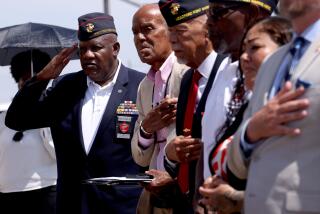Pump Puts Him a Heartbeat Closer to Health
- Share via
When Roger Anderson’s mother died 20 years ago, he thought it over for 20 minutes before he agreed to donate her organs.
Now, Anderson--who at 57 is two years younger than his mother at her death--is in the hospital awaiting a donated heart so he can have a transplant.
Anderson is a lucky man, doctors say. Although his own heart has failed, the Fountain Valley resident was given an experimental portable heart pump--one that made him healthy enough to become a candidate for a transplant at Sharp Memorial Hospital in San Diego.
After a standard balloon pump failed to support Anderson’s heart, doctors had another option: the new pump, the Heartmate, which the U.S. Food and Drug Administration approved a year ago for experimental purposes in humans as a bridge to transplants.
Used for the first time on the West Coast--there are only 50 in the world--the pump has not only kept Anderson alive for 34 days, but has significantly improved his health.
For Anderson, the pump has a mental as well as physical health advantage over the other pumps: It’s portable.
Although other patients in his circumstances would be tethered to pumps and bed-bound, Anderson can and does roam the hospital corridors, pushing a cart carrying a typewriter-size console.
With the Jarvik heart, for instance, patients are less mobile because of the size of the accompanying console, which is about the size of a washing machine. And most patients attached to balloon pumps are bed-bound.
“This gives me mobility--that’s important to me,” said Anderson, sitting in a chair in his hospital room. “I have never been confined. I don’t like to be tied down. I’d be stir-crazy.”
Today, Anderson pedals an exercise bicycle twice a day for 8 1/2 minutes, and he trundles along the hospital corridors. This week, he toted and ate his lunch outside, on the hospital’s garden roof.
The change in his health has been dramatic.
For two weeks in August, Anderson was unconscious. He had suffered a heart attack; his kidneys and liver began to fail. Because he was so ill, he could not be considered for the heart transplant he so desperately needed, said Dr. Walter Dembitsky, director of Sharp’s artificial organs division, as well as co-director of its Cardiopulmonary Transplant Program.
“This guy came down here, he was basically dead,” said Dembitsky, Anderson’s cardiovascular surgeon, who wears black cowboy boots beneath his green surgical scrubs. “Now look at him--he’s in great shape.”
Worldwide, only 50 models of this Heartmate have been used; one has been in place for about 330 days.
The $15,000 Heartmate blood pump, which contains two pig valves, is implanted in the patient’s abdominal cavity. The pump has a “rough” surface to which cells can adhere, forming a biological lining of the patient’s own tissues and therefore reducing the likelihood of blood clots.
The console that operates the compressed-air pump is driven by an electric motor. An extra console is parked outside Anderson’s room, standing ready if needed. Inside his room, the console emits the sound of a heartbeat as it pumps.
In recent months, the FDA approved trial use of a battery-operated electro-mechanical version of the pump--a model so small that the battery fits under the patient’s arm, eliminating the console and the cart.
This model will undergo trials in Texas and, pending approval, at Sharp Memorial Hospital. Unlike the model that Anderson is using as he awaits a transplant, this version can be used instead of a heart transplant because it will function as the body’s artificial heart. Doctors hope this model could remain in place for five to 10 years.
For patients like Anderson, such a device could mean an end to the wait they endure for a donated organ. The need for organs has far outstripped supply.
For the 30,000 to 50,000 potential transplant recipients, only about 1,800 hearts are donated each year in the United States. Some patients die before they receive a new heart--a possibility Anderson now faces.
“I don’t know if I could go 300 days,” said Anderson, a divorced father of three. “My biggest fear: I don’t want to lie in bed and rot away.”
Anderson’s heart attack last month was not his first. Nine years ago, he suffered chest pains as he arrived at Douglas Aircraft, where he worked 30 years on the assembly line.
He had just lit up a cigarette and gulped down some coffee when he felt a sharp pain under his right arm. He puffed another cigarette, and felt a searing, hot pain. He threw the cigarette away--it was his last. After dinner that night, Anderson felt as though his chest had collapsed. On March 3, 1982, he suffered his first heart attack.
Last month, he had his second. Lying down watching television in the den one evening, Anderson began experiencing intense chest pains--pains stronger than any he’d ever felt.
When the ambulance carried him away, he remembered being surprised that the ride was so rough. Every jolt, every bounce seared his chest. He lost consciousness and remembers little else.
“Afraid? I’ve never been afraid,” Anderson said. “I figure there are only two things you can do: live or die.”






